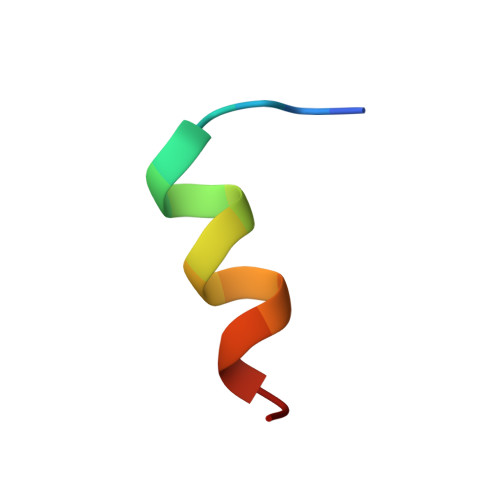Cytoplasmic pro-apoptotic function of the tumor suppressor p73 is mediated through a modified mode of recognition of the anti-apoptotic regulator Bcl-XL.
Yoon, M.-K., Kim, B.-Y., Lee, J.-Y., Ha, J.-H., Kim, S.A., Lee, D.-H., Lee, M.-S., Lee, M.-K., Choi, J.S., Cho, J.H., Kim, J.-H., Kim, S., Song, J., Park, S.G., Park, B.C., Bae, K.-H., Choi, S.U., Chi, S.-W.(2018) J Biol Chem 293: 19546-19558
- PubMed: 30429221
- DOI: https://doi.org/10.1074/jbc.RA118.003061
- Primary Citation of Related Structures:
6IJQ - PubMed Abstract:
In response to genotoxic stress, the tumor suppressor protein p73 induces apoptosis and cell cycle arrest. Despite extensive studies on p73-mediated apoptosis, little is known about the cytoplasmic apoptotic function of p73. Here, using H1299 lung cancer cells and diverse biochemical approaches, including colony formation, DNA fragmentation, GST pulldown, and apoptosis assays along with NMR spectroscopy, we show that p73 induces transcription-independent apoptosis via its transactivation domain (TAD) through a mitochondrial pathway and that this apoptosis is mediated by the interaction between p73-TAD and the anti-apoptotic protein B-cell lymphoma-extra large (Bcl-X L or BCL2L1). This binding disrupted an interaction between Bcl-X L and the pro-apoptotic protein BH3-interacting domain death agonist (Bid). In particular, we found that a 16-mer p73-TAD peptide motif (p73-TAD16) mediates transcription-independent apoptosis, accompanied by cytochrome c release from the mitochondria, by interacting with Bcl-X L Interestingly, the structure of the Bcl-X L -p73-TAD16 peptide complex revealed a novel mechanism of Bcl-X L recognition by p73-TAD. We observed that the α-helical p73-TAD16 peptide binds to a noncanonical site in Bcl-X L , comprising the BH1, BH2, and BH3 domains in an orientation opposite to those of pro-apoptotic BH3 peptides. Taken together, our results indicate that the cytoplasmic apoptotic function of p73 is mediated through a noncanonical mode of Bcl-X L recognition. This finding sheds light on a critical transcription-independent, p73-mediated mechanism for apoptosis induction, which has potential implications for anticancer therapy.
Organizational Affiliation:
From the Disease Target Structure Research Center and.















